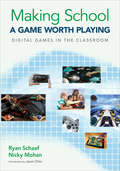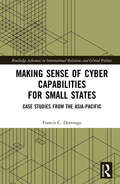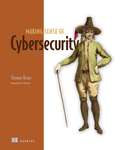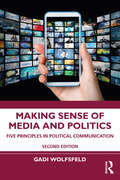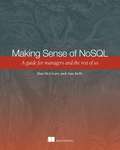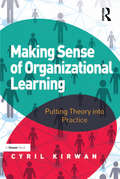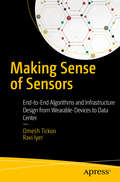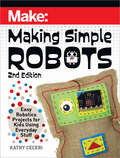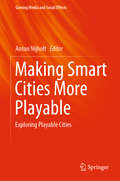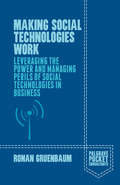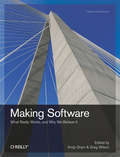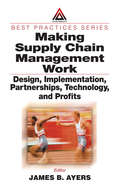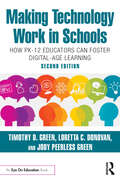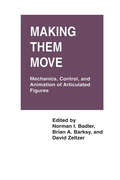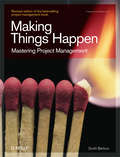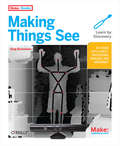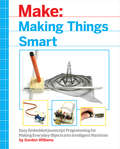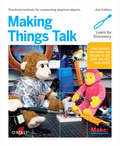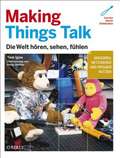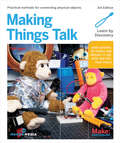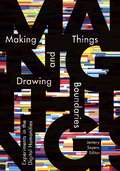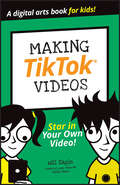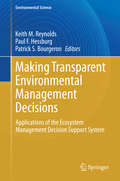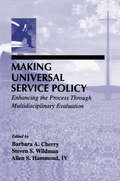- Table View
- List View
Making School a Game Worth Playing: Digital Games in the Classroom
by Dr Ryan L. Schaaf Ms Nicky MohanIntegrate game-based learning for 21st Century skills success! This straightforward, easy-to-follow guide from experts Schaaf and Mohan helps you leverage technology students love best – digital video games. With step-by-step strategies, you’ll easily find, evaluate, and integrate gaming into your existing lesson plans or completely redesign your classroom. Teachers learn to use well-designed game elements to: Promote meaningful student buy-in Create student-centered, collaborative learning spaces Teach and assess 21st Century Fluencies aligned to Common Core State Standards Address multiple intelligences using research-based strategies Includes a detailed implementation outline. Create engaged, adventure-filled learning with this resourceful guide!
Making Sense of Cyber Capabilities for Small States: Case Studies from the Asia-Pacific (Routledge Advances in International Relations and Global Politics)
by Francis C. DomingoDomingo explores the potential of cyber capabilities for small states in the Asia-Pacific, the most active region for cyber conflict. He develops a systematic explanation for why Brunei, New Zealand, and Singapore have developed or are developing cyber capabilities. Studies on cyber conflict and strategy have substantially increased in the past decade but most have focused on the cyber operations of powerful states. This book moves away from the prominence of powerful states and explores the potential of cyber capabilities for small states in the Asia-Pacific, the most active region for cyber conflict. It develops a systematic explanation of why Brunei, New Zealand, and Singapore have developed or are developing cyber capabilities despite its obscure strategic value. The book argues that the distribution of power in the region and a "technology-oriented" strategic culture are two necessary conditions that influence the development of cyber capabilities in small states. Following this argument, the book draws on neoclassical realism as a theoretical framework to account for the interaction between these two conditions. The book also pursues three secondary objectives. First, it aims to determine the constraints and incentives that affect the utilization of cyber capabilities as foreign policy instruments. Second, the book evaluates the functionality of these cyber capabilities for small states. Lastly, it assesses the implications of employing cyber capabilities as foreign policy tools of small states. This book will be an invaluable resource for academics and security analysts working on cyber conflict, military strategy, small states, and International Relations in general.
Making Sense of Cybersecurity
by Thomas KranzA jargon-busting guide to the key concepts, terminology, and technologies of cybersecurity. Perfect for anyone planning or implementing a security strategy. In Making Sense of Cybersecurity you will learn how to: Develop and incrementally improve your own cybersecurity strategy Detect rogue WiFi networks and safely browse on public WiFi Protect against physical attacks utilizing USB devices or building access cards Use the OODA loop and a hacker mindset to plan out your own attacks Connect to and browse the Dark Web Apply threat models to build, measure, and improve your defenses Respond to a detected cyber attack and work through a security breach Go behind the headlines of famous attacks and learn lessons from real-world breaches that author Tom Kranz has personally helped to clean up. Making Sense of Cybersecurity is full of clear-headed advice and examples that will help you identify risks in your organization and choose the right path to apply the important security concepts. You'll learn the three pillars of a successful security strategy and how to create and apply threat models that will iteratively improve your organization's readiness. Foreword by Naz Markuta. About the technology Someone is attacking your business right now. Understanding the threats, weaknesses, and attacks gives you the power to make better decisions about how to secure your systems. This book guides you through the concepts and basic skills you need to make sense of cybersecurity. About the book Making Sense of Cybersecurity is a crystal-clear overview of common cyber threats written for business and technical readers with no background in security. You&’ll explore the core ideas of cybersecurity so you can effectively talk shop, plan a security strategy, and spot your organization&’s own weak points. By examining real-world security examples, you&’ll learn how the bad guys think and how to handle live threats. What's inside Develop and improve your cybersecurity strategy Apply threat models to build, measure, and improve your defenses Detect rogue WiFi networks and safely browse on public WiFi Protect against physical attacks About the reader For anyone who needs to understand computer security. No IT or cybersecurity experience required. About the author Tom Kranz is a security consultant with over 30 years of experience in cybersecurity and IT. Table of Contents 1 Cybersecurity and hackers 2 Cybersecurity: Everyone&’s problem PART 1 3 Understanding hackers 4 External attacks 5 Tricking our way in: Social engineerin 6 Internal attacks 7 The Dark Web: Where is stolen data traded? PART 2 8 Understanding risk 9 Testing your systems 10 Inside the security operations center 11 Protecting the people 12 After the hack
Making Sense of Media and Politics: Five Principles in Political Communication
by Gadi WolfsfeldIn Making Sense of Media and Politics, Gadi Wolfsfeld introduces readers to the most important concepts for examining the interrelationship of media and politics. Five major principles are used to summarize the major arguments: Political power can usually be translated into power over all forms of media. When the powerful lose control over the political environment, they also lose control over all forms of media. Every political story that appears in every form of media is biased. All forms of media are primarily dedicated to telling good stories, which can have a major impact on political processes. Many of the most important effects of the various forms of media on citizens tend to be unintentional and unnoticed. By identifying these five key principles of political communication, Wolfsfeld examines those who package and send political messages, those who transform political messages into stories, and the effects this can have on citizens, and how the more active members of the public ("users") can initiate their own stories. The result is a brief, engaging guide to help make sense of the wider world of media and politics and an essential companion to more in-depths studies of the field. New to the Second Edition Up-to-date coverage of major political events in the last decade, including the landmark US elections of 2016 and 2020. Devotes more attention to the "hybrid media system" that has developed over the last decade, providing a greater balance between traditional "news" and social media in particular. Includes more cross-national research, especially in non-Western and non-democratic countries. Refines the five principles of political communication to better reflect contemporary media trends. Covers key emerging topics including misinformation and threats to democratic institutions, new forms of political engagement, and the economic base of the various forms of media.
Making Sense of NoSQL: A guide for managers and the rest of us
by Ann Kelly Dan McCrearySummaryMaking Sense of NoSQL clearly and concisely explains the concepts, features, benefits, potential, and limitations of NoSQL technologies. Using examples and use cases, illustrations, and plain, jargon-free writing, this guide shows how you can effectively assemble a NoSQL solution to replace or augment the traditional RDBMS you have now.About this BookIf you want to understand and perhaps start using the new data storage and analysis technologies that go beyond the SQL database model, this book is for you. Written in plain language suitable for technical managers and developers, and using many examples, use cases, and illustrations, this book explains the concepts, features, benefits, potential, and limitations of NoSQL.Making Sense of NoSQL starts by comparing familiar database concepts to the new NoSQL patterns that augment or replace them. Then, you'll explore case studies on big data, search, reliability, and business agility that apply these new patterns to today's business problems. You'll see how NoSQL systems can leverage the resources of modern cloud computing and multiple-CPU data centers. The final chaptersshow you how to choose the right NoSQL technologies for your own needs.Managers and developers will welcome this lucid overview of the potential and capabilities of NoSQL technologies.Purchase of the print book includes a free eBook in PDF, Kindle, and ePub formats from Manning Publications.What's InsideNoSQL data architecture patternsNoSQL for big dataSearch, high availability, and securityChoosing an architectureAbout the AuthorsDan McCreary and Ann Kelly lead an independent training and consultancy firm focused on NoSQL solutions and are cofounders of the NoSQL Now! Conference.Table of ContentsPART 1 INTRODUCTIONNoSQL: It's about making intelligent choicesNoSQL conceptsPART 2 DATABASE PATTERNSFoundational data architecture patternsNoSQL data architecture patternsNative XML databasesPART 3 NOSQL SOLUTIONSUsing NoSQL to manage big dataFinding information with NoSQL searchBuilding high-availability solutions with NoSQLIncreasing agility with NoSQLPART 4 ADVANCED TOPICSNoSQL and functional programming Security: protecting data in your NoSQL systems Selecting the right NoSQL solution
Making Sense of Organizational Learning: Putting Theory into Practice
by Cyril KirwanThe ability of a business to engage in real organizational learning and to do so faster and in a more sustainable way than its competitors is being increasingly seen as an essential component of success. In Making Sense of Organizational Learning, Cyril Kirwan examines the wide range of factors necessary to create and sustain organizational learning and knowledge at all levels. At the individual level, the generation of continuous learning opportunities and reflection on experiences are critically important. At the team level, it’s about encouraging collaboration, team learning and the sharing of knowledge. At the organizational level, the emphasis is on building systems to capture and share knowledge and providing strategic leadership for learning. The book shows you how you can best exploit the knowledge that already exists within your organization while at the same time develop the capability of the people that work there. It deals in turn with individual learning; learning with others; learning in organizations; and in particular the role of the HR function and of line managers. Each chapter provides theoretical background and real-world examples. Diagnostic questionnaires, checklists and other tools are also included. Making Sense of Organizational Learning provides an evidence-based argument for the adoption of effective organizational learning policies and practices, and offers a real opportunity to improve performance. Thinking practitioners working in and around learning and development or organization development will find it invaluable, as will those undertaking post-graduate study in HR and related disciplines.
Making Sense of Sensors
by Omesh Tickoo Ravi IyerMake the most of the common architectures used for deriving meaningful data from sensors. This book provides you with the tools to understand how sensor data is converted into actionable knowledge and provides tips for in-depth work in this field.Making Sense of Sensors starts with an overview of the general pipeline to extract meaningful data from sensors. It then dives deeper into some commonly used sensors and algorithms designed for knowledge extraction. Practical examples and pointers to more information are used to outline the key aspects of Multimodal recognition. The book concludes with a discussion on relationship extraction, knowledge representation, and management. In today’s world we are surrounded by sensors collecting various types of data about us and our environments. These sensors are the primary input devices for wearable computers, IoT, and other mobile devices. The information is presented in way that allows readers to associate the examples with their daily lives for better understanding of the concepts.What You'll LearnLook at the general architecture for sensor based data Understand how data from common domains such as inertial, visual and audio is processedMaster multi-modal recognition using multiple heterogeneous sensorsTransition from recognition to knowledge through relationship understanding between entitiesLeverage different methods and tools for knowledge representation and managementWho This Book Is ForNew college graduates and professionals interested in acquiring knowledge and the skills to develop innovative solutions around today's sensor-rich devices.
Making Simple Robots: Easy Robotics Projects for Kids Using Everyday Stuff
by Kathy CeceriMaking Simple Robots is based on the idea that anybody can build a robot! That includes kids, educators, parents, and anyone who didn't make it to engineering school. If you can cut, fold, and tape a piece of paper to make a tube or a box, you can build a no-tech robotic part. In fact, many of the models in this book are based upon real-life prototypes -- working models created in research labs and companies. What's more, if you can use the apps on your smartphone, you can quickly learn to tell robots what to do using free, online, beginner-level software like MIT's Scratch and Microsoft MakeCode.The projects in this book which teach you about electric circuits by making jumping origami frogs with eyes that light up when you get them ready to hop. You'll practice designing all-terrain robot wheel-legs with free, online Tinkercad software, and you'll create files ready for 3D printing. You'll also learn to sew -- and code -- a cyborg rag doll with a blinking electronic "eye."Each project includes step-by-step directions and clear illustrations and photographs. Along the way, you'll learn about the real research behind the DIY version, find shortcuts for making projects easier when needed, and get suggestions for adding to the challenge as your skill set grows.
Making Smart Cities More Playable: Exploring Playable Cities (Gaming Media and Social Effects)
by Anton NijholtThis book explores the ways in which the broad range of technologies that make up the smart city infrastructure can be harnessed to incorporate more playfulness into the day-to-day activities that take place within smart cities, making them not only more efficient but also more enjoyable for the people who live and work within their confines. The book addresses various topics that will be of interest to playable cities stakeholders, including the human–computer interaction and game designer communities, computer scientists researching sensor and actuator technology in public spaces, urban designers, and (hopefully) urban policymakers. This is a follow-up to another book on Playable Cities edited by Anton Nijholt and published in 2017 in the same book series, Gaming Media and Social Effects.
Making Social Technologies Work: Leveraging the Power and Managing Perils of Social Technologies in Business (Palgrave Pocket Consultants)
by Ronan GruenbaumEmbracing social technologies at work is not just a blog from the CEO. It is about understanding all the opportunities where social media and technology activities could improve your company from marketing to operations. A practical guide for managers and an informative window into the world of social technologies in business.
Making Software: What Really Works, and Why We Believe It (O'reilly Ser.)
by Andy Oram Greg WilsonMany claims are made about how certain tools, technologies, and practices improve software development. But which claims are verifiable, and which are merely wishful thinking? In this book, leading thinkers such as Steve McConnell, Barry Boehm, and Barbara Kitchenham offer essays that uncover the truth and unmask myths commonly held among the software development community. Their insights may surprise you.Are some programmers really ten times more productive than others?Does writing tests first help you develop better code faster?Can code metrics predict the number of bugs in a piece of software?Do design patterns actually make better software?What effect does personality have on pair programming?What matters more: how far apart people are geographically, or how far apart they are in the org chart?Contributors include:Jorge ArandaTom BallVictor R. BasiliAndrew BegelChristian BirdBarry BoehmMarcelo CataldoSteven ClarkeJason CohenRobert DeLineMadeline DiepHakan ErdogmusMichael GodfreyMark GuzdialJo E. HannayAhmed E. HassanIsrael HerraizKim Sebastian HerzigCory KapserBarbara KitchenhamAndrew KoLucas LaymanSteve McConnellTim MenziesGail MurphyNachi NagappanThomas J. OstrandDewayne PerryMarian PetreLutz PrecheltRahul PremrajForrest ShullBeth SimonDiomidis SpinellisNeil ThomasWalter TichyBurak TurhanElaine J. WeyukerMichele A. WhitecraftLaurie WilliamsWendy M. WilliamsAndreas ZellerThomas Zimmermann
Making Supply Chain Management Work: Design, Implementation, Partnerships, Technology, and Profits (Resource Management)
by James B. AyersAny supply chain improvement project, even if well conceived, has a good chance of failing, unless the accompanying information technology enables the design. Being prepared, understanding the risks and how to reduce them, will give you the edge you need. Combining a technology focus with practical advice, Making Supply Chain Management Work: Desig
Making Technology Work in Schools: How PK-12 Educators Can Foster Digital-Age Learning
by Timothy D. Green Loretta C. Donovan Jody Peerless GreenMaking Technology Work in Schools is an easy-to-use guide for transforming your school into a learner-centered, tech-supportive environment. School systems are increasingly adopting ambitious new educational technologies, but how do you make sure they are yielding effective teaching and learning experiences? The authors’ proven, intuitive practices speak directly to academic coaches, school technology leads, district technology directors, and teachers on special assignment who are responsible for introducing new digital tools and programs. Retaining its substantive focus on educational change and the comprehensive PURPOSE Framework, this refreshed second edition updates its real-world examples, practical strategies, and technology categories while adding new content on schoolwide initiatives, needs analysis, professional development, leadership and coaching standards, and more. After reading this book, you will be able to better prepare the educators whom you serve to empower their learners, whether digitally savvy or not, to be engaged, collaborative, and ready for college and careers.
Making Them Move: Mechanics, Control & Animation of Articulated Figures
by David Zeltzer Norman Badler Brian BarskyCurrent computer graphics hardware and software make it possible to synthesize near photo-realistic images, but the simulation of natural-looking motion of articulated figures remains a difficultand challenging task. Skillfully rendered animation of humans, animals, and robots can delight and move us, but simulating their realistic motion holds great promise for many other applications as well, including ergonomic engineering design, clinical diagnosis of pathological movements, rehabilitation therapy, and biomechanics.Making Them Move presents the work of leading researchers in computer graphics, psychology, robotics and mechanical engineering who were invited to attend the Workshop on the Mechanics, Control and Animation of ArticulatedFigures held at the MIT Media Lab in April 1989. The book explores biological and robotic motor control, as well as state-of-the-art computergraphics techniques for simulating human and animal figures in a natural and physically realistic manner.
Making Things Happen: Mastering Project Management
by Scott BerkunIn the updated edition of this critically acclaimed and bestselling book, Microsoft project veteran Scott Berkun offers a collection of essays on field-tested philosophies and strategies for defining, leading, and managing projects. Each essay distills complex concepts and challenges into practical nuggets of useful advice, and the new edition now adds more value for leaders and managers of projects everywhere.Based on his nine years of experience as a program manager for Internet Explorer, and lead program manager for Windows and MSN, Berkun explains to technical and non-technical readers alike what it takes to get through a large software or web development project. Making Things Happen doesn't cite specific methods, but focuses on philosophy and strategy. Unlike other project management books, Berkun offers personal essays in a comfortable style and easy tone that emulate the relationship of a wise project manager who gives good, entertaining and passionate advice to those who ask.Topics in this new edition include:How to make things happenMaking good decisionsSpecifications and requirementsIdeas and what to do with themHow not to annoy peopleLeadership and trustThe truth about making datesWhat to do when things go wrongComplete with a new forward from the author and a discussion guide for forming reading groups/teams, Making Things Happen offers in-depth exercises to help you apply lessons from the book to your job. It is inspiring, funny, honest, and compelling, and definitely the one book that you and your team need to have within arm's reach throughout the life of your project.Coming from the rare perspective of someone who fought difficult battles on Microsoft's biggest projects and taught project design and management for MSTE, Microsoft's internal best practices group, this is valuable advice indeed. It will serve you well with your current work, and on future projects to come.
Making Things See: 3D vision with Kinect, Processing, Arduino, and MakerBot
by Greg BorensteinThis detailed, hands-on guide provides the technical and conceptual information you need to build cool applications with Microsoft’s Kinect, the amazing motion-sensing device that enables computers to see. Through half a dozen meaty projects, you’ll learn how to create gestural interfaces for software, use motion capture for easy 3D character animation, 3D scanning for custom fabrication, and many other applications.Perfect for hobbyists, makers, artists, and gamers, Making Things See shows you how to build every project with inexpensive off-the-shelf components, including the open source Processing programming language and the Arduino microcontroller. You’ll learn basic skills that will enable you to pursue your own creative applications with Kinect.Create Kinect applications on Mac OS X, Windows, or LinuxTrack people with pose detection and skeletonization, and use blob tracking to detect objectsAnalyze and manipulate point cloudsMake models for design and fabrication, using 3D scanning technologyUse MakerBot, RepRap, or Shapeways to print 3D objectsDelve into motion tracking for animation and gamesBuild a simple robot arm that can imitate your arm movementsDiscover how skilled artists have used Kinect to build fascinating projects
Making Things Smart: Easy Embedded JavaScript Programming for Making Everyday Objects into Intelligent Machines
by Gordon F. WilliamsMaking Things Smart teaches the fundamentals of the powerful ARM microcontroller by walking beginners and experienced users alike through easily assembled projects comprised of inexpensive, hardware-store parts.Current ARM programming books take a bland, textbook approach focused on complex, beginner-unfriendly languages like C or ARM Assembler. Making Things Smart uses Espruino (JavaScript for Hardware), flattening the learning curve.
Making Things Talk
by Tom IgoeMake microcontrollers, PCs, servers, and smartphones talk to each other. Building electronic projects that interact with the physical world is good fun. But when the devices you've built start to talk to each other, things really get interesting. With 33 easy-to-build projects, Making Things Talk shows you how to get your gadgets to communicate with you and your environment. It's perfect for people with little technical training but a lot of interest. Maybe you're a science teacher who wants to show students how to monitor the weather in several locations at once. Or a sculptor looking to stage a room of choreographed mechanical sculptures. In this expanded edition, you'll learn how to form networks of smart devices that share data and respond to commands. Call your home thermostat with a smartphone and change the temperature. Create your own game controllers that communicate over a network. Use ZigBee, Bluetooth, Infrared, and plain old radio to transmit sensor data wirelessly. Work with Arduino 1.0, Processing, and PHP--three easy-to-use, open source environments. Write programs to send data across the Internet, based on physical activity in your home, office, or backyard. Whether you want to connect simple home sensors to the Internet, or create a device that can interact wirelessly with other gadgets, this book explains exactly what you need.
Making Things Talk (Make)
by Tom IgoeEs macht Spaß, elektronische Dinge zu bauen, die mit der realen Welt interagieren. Aber so richtig cool wird's erst, wenn die Dinge anfangen sich untereinander zu unterhalten. Mit 33 leicht nachzubauenden Projekten wird dir in Making Things Talk - Die Welt hören, sehen, fühlen gezeigt, wie du deine Gadgets dazu bringst, mit dir und mit der Umwelt zu kommunizieren. Das Buch ist genau für die geschrieben, die zwar nur wenig technische Erfahrung, dafür aber umso mehr geekige Neugierde mitbringen. Lass Mikrocontroller, PCs, Server und Smartphones miteinander quatschen. Vielleicht willst du deinen Freunden zeigen, wie man das Wetter aus unterschiedlichen Teilen der Welt clever darstellen kann. Vielleicht bist du aber auch eine Künstlerin, die ihren Skulpturen mechanisches Leben einhauchen möchte. In diesem Standardwerk lernst du, wie man Geräte-Netzwerke schafft, die sich Daten teilen und auf Befehle von außen reagieren. Mit ein wenig Elektronikgrundwissen, preiswerten Mikrocontrollern und ein paar Netzwerkmodulen baust du coole Projekte: Blink - Dein allererstes Programm Monski Pong - Steuere ein Computerspiel mit einem flauschigen, pinkfarbenen Stoffäffchen Internet-Luftqualitätsmesser - Bau eine Internet-Messstation für Luftqualität Giftwarnung in der Werkstatt - Verwende ein XBee-Modul, Sensoren und ein Stofftier, um dich vor giftigen Dämpfen warnen zu lassen. Bluetooth GPS - Bau einen batteriebetriebenes GPS-Gerät, das via Bluetooth seinen Standort mitteilt. Tweets mit RFID - Lese einen Twitter-Stream via RFID-Tags.
Making Things Talk: Using Sensors, Networks, and Arduino to See, Hear, and Feel Your World
by Tom IgoeThe workbenches of hobbyists, hackers, and makers have become overrun with microcontrollers, computers-on-a-chip that power homebrewed video games, robots, toys, and more. In Making Things Talk, Tom Igoe, one of the creators of Arduino, shows how to make these gadgets talk. Whether you need to connect some sensors to the Internet or create a device that can interact wirelessly with other creations, this book shows you what you need. Although they are powerful, the projects in this book are inexpensive to build: the Arduino microcontroller board itself ranges from around $25 to $40. The networking hardware covered here includes Ethernet, Wi-Fi, Bluetooth, and can be had for $25 to $50. Fully updated for the latest Arduino hardware and software, this book lets you combine microcontrollers, sensors, and networking hardware to make things... and make them talk to each other!
Making Things and Drawing Boundaries: Experiments in the Digital Humanities (Debates in the Digital Humanities)
by Jentery SayersIn Making Things and Drawing Boundaries, critical theory and cultural practice meet creativity, collaboration, and experimentation with physical materials as never before. Foregrounding the interdisciplinary character of experimental methods and hands-on research, this collection asks what it means to &“make&” things in the humanities. How is humanities research manifested in hand and on screen alongside the essay and monograph? And, importantly, how does experimentation with physical materials correspond with social justice and responsibility? Comprising almost forty chapters from ninety practitioners across twenty disciplines, Making Things and Drawing Boundaries speaks directly and extensively to how humanities research engages a growing interest in &“maker&” culture, however &“making&” may be defined.Contributors: Erin R. Anderson; Joanne Bernardi; Yana Boeva; Jeremy Boggs; Duncan A. Buell; Amy Burek; Trisha N. Campbell; Debbie Chachra; Beth Compton; Heidi Rae Cooley; Nora Dimmock; Devon Elliott; Bill Endres; Katherine Faull; Alexander Flamenco; Emily Alden Foster; Sarah Fox; Chelsea A. M. Gardner; Susan Garfinkel; Lee Hannigan; Sara Hendren; Ryan Hunt; John Hunter; Diane Jakacki; Janelle Jenstad; Edward Jones-Imhotep; Julie Thompson Klein; Aaron D. Knochel; J. K. Purdom Lindblad; Kim Martin; Gwynaeth McIntyre; Aurelio Meza; Shezan Muhammedi; Angel David Nieves; Marcel O&’Gorman; Amy Papaelias; Matt Ratto; Isaac Record; Jennifer Reed; Gabby Resch; Jennifer Roberts-Smith; Melissa Rogers; Daniela K. Rosner; Stan Ruecker; Roxanne Shirazi; James Smithies; P. P. Sneha; Lisa M. Snyder; Kaitlyn Solberg; Dan Southwick; David Staley; Elaine Sullivan; Joseph Takeda; Ezra Teboul; William J. Turkel; Lisa Tweten.
Making TikTok Videos (Dummies Junior)
by Andrew Cooper Claire Cohen Will Eagle Hannah Budke Jordan Elijah Michael Andrew PanturescuCreate videos using the tricks of TikTok stars! Making TikTok Videos reveals the secrets that TikTok celebs and influencers use to make the videos that everyone’s watching. Hilarious clips, the latest dances, instruction videos—whatever you want to do, make sure it shows off the latest TikTok styles. This book shows you how to use whatever you have on hand to record, edit, and upload TikToks. Add music and text, get creative, and start sharing your finished products. With this guide, you’ll get easy instructions on how to make videos that people remember. You also get some tips on how to bring viewers to your account. Use your mobile device to shoot videos with top-notch sound Learn the editing tricks TikTok pros use to create a finished video Set up your TikTok account and set your privacy Keep up with the latest TikTok video stylesWritten especially for the 10-14 age group interested in creating their first TikTok videos, this Dummies Jr. title will help you get plugged into the TikTok universe.
Making Transparent Environmental Management Decisions
by Keith M. Reynolds Paul F. Hessburg Patrick S. BourgeronSince 1997, the Ecosystem Management Decision Support (EMDS) system has been used around the world to support environmental analysis and planning in many different application areas, and it has been applied over a wide range of geographic scales, from forest stands to entire countries. An extensive sampling of this diversity of applications is presented in section 2, in which EMDS application developers describe the varied uses of the system. These accounts, together with the requisite background in section 1, provide valuable practical insights into how the system can be applied in the general domain of environmental management.
Making Universal Service Policy: Enhancing the Process Through Multidisciplinary Evaluation (LEA Telecommunications Series)
by Iv Barbara A. Cherry Steven S. Wildman Allen S. HammondThis book is the outgrowth of shared interests between the editors and the contributing authors to provide a multidisciplinary perspective in evaluating universal service policy and recommending policy changes to accommodate a more competitive telecommunications environment. The book is interdisciplinary in nature to reflect the extremely complex context in which universal service policy is formed. The chapter authors represent a broad cross-section of disciplinary training, professional positions, and relationships in the telecommunications industry. Academic disciplines represented include law, economics, anthropology, communication, and business. This book's purpose is to significantly enhance the development of effective telecommunications universal service policy among policymakers, industry members, and stakeholders in the United States. Universal service policy has been, and will continue to be, both enabled and constrained by the simultaneous interaction of social, political, technological, and economic forces in the environment in which it is formed. A more effective process for policy design is to seek agreement on how entitlements embedded in universal service policy should be modified as circumstances invariably change over time. Therefore, the volume reflects recent significant developments in U.S. universal service policy--the implementation of which continues to unfold.
Making Virtual Worlds: Linden Lab and Second Life
by Thomas M. MalabyThe past decade has seen phenomenal growth in the development and use of virtual worlds. In one of the most notable, Second Life, millions of people have created online avatars in order to play games, take classes, socialize, and conduct business transactions. Second Life offers a gathering point and the tools for people to create a new world online. Too often neglected in popular and scholarly accounts of such groundbreaking new environments is the simple truth that, of necessity, such virtual worlds emerge from physical workplaces marked by negotiation, creation, and constant change. Thomas Malaby spent a year at Linden Lab, the real-world home of Second Life, observing those who develop and profit from the sprawling, self-generating system they have created. Some of the challenges created by Second Life for its developers were of a very traditional nature, such as how to cope with a business that is growing more quickly than existing staff can handle. Others are seemingly new: How, for instance, does one regulate something that is supposed to run on its own? Is it possible simply to create a space for people to use and then not govern its use? Can one apply these same free-range/free-market principles to the office environment in which the game is produced? "Lindens"-as the Linden Lab employees call themselves-found that their efforts to prompt user behavior of one sort or another were fraught with complexities, as a number of ongoing processes collided with their own interventions. Malaby thoughtfully describes the world of Linden Lab and the challenges faced while he was conducting his in-depth ethnographic research there. He shows how the workers of a very young but quickly growing company were themselves caught up in ideas about technology, games, and organizations, and struggled to manage not only their virtual world but also themselves in a nonhierarchical fashion. In exploring the practices the Lindens employed, he questions what was at stake in their virtual world, what a game really is (and how people participate), and the role of the unexpected in a product like Second Life and an organization like Linden Lab.
